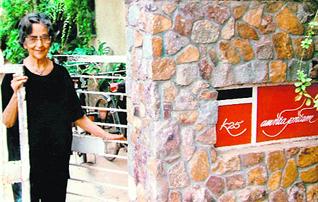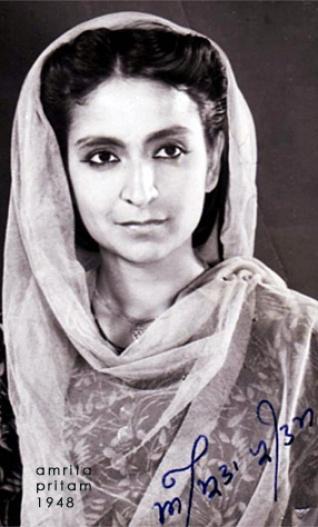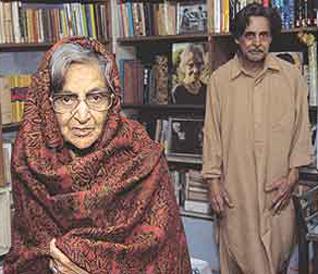Architecture
Reducing Heritage To A Wasteland: Amrita Pritam's Home Is No More
by NIRUPAMA DUTT
The month of May was not a merry one, certainly not for the lovers of art and literature, for it marked the sad end of a dream, a dream turned into reality by one of the most celebrated poets of our times, who enjoyed a cult status in her lifetime and continues to do so even now. It took almost a month for the sad tidings to reach the literary world.
A couple of weeks ago, Surinder Sharma, a Patiala-based literary buff, was on the telephone. Sharma has a fetish for calling up friends and telling jokes from his vast repertoire. But this time, he was not joking. He was almost sobbing as he said: "K-25, Hauz Khas, has been sold and already demolished. Imroz went to see it being bulldozed."
I was not shocked because the news had come to me from another Amrita-Imroz fan, but I shared his grief, as do many others.
"This is so terrible, we have seen great edifices come up and then be destroyed within our lifetimes," Sharma lamented. Thinking of Imroz (86), who has been like a boat without anchor ever since he lost the woman who was his world, one wondered if this could not be the final blow for him.
However, a Hindi poet, lamenting this loss, says: "The market waits for none. See what it does to human beings. [Hundreds of thousands] don’t matter anymore, now the human mind yearns for [tens of millions]. In such a scenario, what is the value of memories, or wishes for that matter?"
London-based Punjabi poet Amarjit Singh Chandan says in anguish: "I feel awful, outraged and ashamed about our neglect of our heritage. I have been to many homes of Western writers, like Johann Goethe’s in Frankfurt, John Keat’s in North London and William Wordsworth’s in the Lake District. Great men belong to the whole mankind. Having visited western writers’ well-preserved homes makes me think what an ungrateful lot we Punjabis are."
Deeply affected by this demolition of dreams, the song that comes to mind is in the voice of legendary singer Kundan Lal Saigal: Ik bangla bane nyara, Basse kunba jis mein saara (The bungalow should be unique/ And the whole clan should inhabit it).
Alas! This is the melody that has caused pain whenever an old house has been sold, including the house our late father built.
All know well that Amrita Pritam (1919-2005) began her poetic journey when just 12. Married at 16, she won critical acclaim for her book Thandian Kirnan in 1935 and there was no looking back. Author of over 100 books, she was widely published in Punjabi, Hindi, Urdu and also translated into English, Russian, French and several other languages. In a literary career spanning seven decades, she did Punjabi proud by bringing it the highest of national and international awards and honours. Not only was her contribution great in poetry and prose, she also provided a platform to young Punjabi writers in her magazine Nagmani, which she edited for 33 long years.
Among the awards she received were the Jnanpith, Sahitya Akademi Award, Cyril and Methodious Award from Bulgari, and the Ordre des Arts des Lettres from France. The Delhi Government declared her the Poet of the Millennium at the turn of the century. Interestingly, the same title was bestowed upon her by the Punjabi Academy, Lahore. In short, she reached a status that no other Punjabi writer has reached so far.
Beautiful, charismatic and a romantic to the core, the story of Amrita’s life is one of amazing courage, resilience and achievement. What set her a class apart from others was her very romantic search for freedom and the desire to live life on her own terms. Walking out of a loveless marriage (she was given away in an arranged marriage at 16), she made her home with artist Imroz and the relationship lasted over four decades.
If Virginia Woolf had spoken for the need of a room of one’s own for a woman writer, Amrita took it forward to a home of one’s own. She had lived in her father’s home, then her husband’s home, but K-25 was all her own. This was made possible by a plot allotted to her, and other prominent artists and writers, who were ravaged from Lahore by Partition, by then rehabilitation commissioner M.S. Randhawa.
Amrita’s neighbours included Bhapa Pritam Singh, Kartar Singh Duggal and painter Jaswant Singh.
But K-25 was different. It was also the love nest of Amrita and Imroz with her two children, Kandla and Navraj, growing up in it and living there for many years. It was willed to Navraj, on whom the mother doted and she felt he would honour her wish and will of retaining the first floor, where she and Imroz lived, as it was.
The house was full of art, poetry and memories. There was the Harshingar tree that the two had planted together, the bougainvilleas that trailed into windows, the painted dining table, portrait after portrait of Amrita by Imroz, her poems written out by him on lampshades, pen stands, clocks and what not. He had made it a memorial to her well within her life.
Poet Parminderjit, who edits Akhar at Amritsar, recalls: "The doors of K-25 were always open to Punjabi writers. She nurtured two generations of writers in her magazine".
Frequent visitors to this haven were Shiv Kumar Batalvi, Dalip Kaur Tiwana, Gurdial Singh and a host of others. Writers from Pakistan would come specially to see her and she had hosted a mushaira for Faiz Ahmad Faiz on her terrace. Sahir Ludhianvi, even when their romance had ended, visited Amrita and Imroz here. I have memories of Gulzar and Deepti Naval sitting by her bedside when the latter was planning her debut book of poems in Hindi. I have spent ever so many nights in her library, which also served as a guest room during my visits to Delhi from Chandigarh.
And Imroz? Where is he now?
Well the inheritor of Amrita’s estate and her only son has been thoughtful enough to place Imroz and the Amrita memorabilia in a small anonymous builder’s flat in Greater Kailash I. He did not spare himself the pain of seeing the edifice bulldozed and he tells with his usual childlike glee: "I brought away the nameplate and now I will frame and keep it."
A brave lover, who willed his life to Amrita, Imroz retains his sanity by outpourings on paper and his humour by letting society climbers, who are wannabe Amritas, pamper and cheer him. This too shall pass.
But Amritaji, how does one come to terms with one of the greatest ‘Punjabans’ caught in the eternal tussle of ‘sons and lovers’. And what about the make-believe that surrounded her? Perhaps, she knew that the real memorial will be her poetry.
Adieu K-25, and we let your poem guide us to your true home:
Today I have erased the number of my house
And removed the stain of identity on my street’s forehead
And I have wiped the direction on each road
But if you really want to meet me
Then knock at the doors of every country
Every city, every street
And wherever a glimpse of a free spirit exists
That will be my home ...
[Courtesy: Tribune]
July 10 2011
Conversation about this article
1: Roop Dhillon (Reigate, United Kingdom), July 10, 2011, 10:15 AM.
Disgusting.
2: Gurmeet Kaur (Atlanta, Georgia, U.S.A.), July 11, 2011, 10:36 PM.
Shocking. Unbelievable. Utterly disgraceful.
3: Noor (U.S.A.), July 17, 2011, 8:56 PM.
This was the house where I grew up. There will be never a home to go back to in India anymore. Just the memories ...






